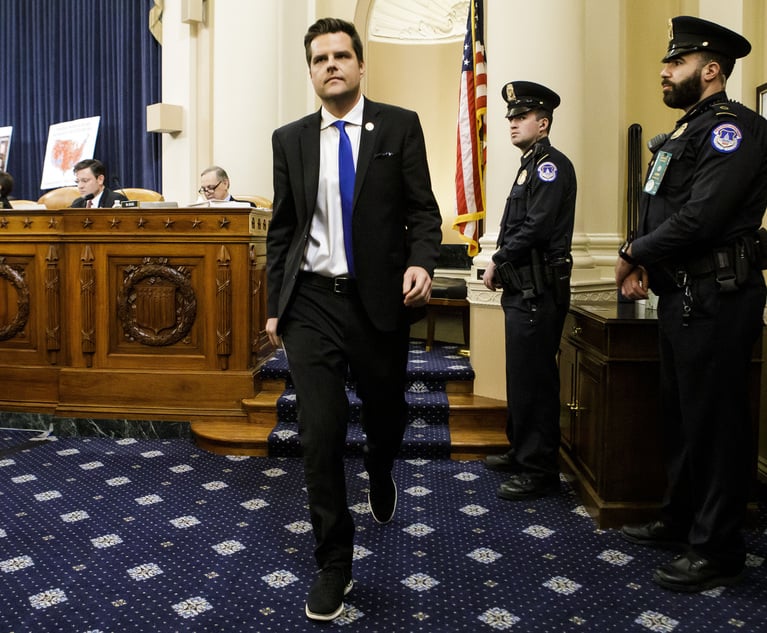Recorded Depositions: Another COVID-19 Casualty in New York State?
As we emerge, albeit haltingly, from the pandemic, virtual depositions are seeing the light of litigation … or at least they are trying to.
September 10, 2021 at 11:45 AM
7 minute read
 Although not a new phenomenon, virtual depositions became indispensable to the COVID-19 pandemic litigator. Courts, attorneys and their clients were forced to learn how to navigate virtual platforms such as Zoom, Microsoft Teams and Skype, among others, to keep up with legal proceedings while prioritizing safety and health. Now, as we emerge, albeit haltingly, from the pandemic, those depositions are seeing the light of litigation … or at least they are trying to.
Although not a new phenomenon, virtual depositions became indispensable to the COVID-19 pandemic litigator. Courts, attorneys and their clients were forced to learn how to navigate virtual platforms such as Zoom, Microsoft Teams and Skype, among others, to keep up with legal proceedings while prioritizing safety and health. Now, as we emerge, albeit haltingly, from the pandemic, those depositions are seeing the light of litigation … or at least they are trying to.
As a threshold matter, it is important to appreciate that videoconference depositions and video-recorded depositions are distinctly different devices used in the realm of virtual depositions. "The former uses remote technology to conduct a deposition; the latter records and preserves the deposition in video format that could one day serve as a substitute for live testimony." Alcorn v. City of Chi., 336 F.R.D. 440, 444. However, the record features of third-party platforms, such as Zoom, have blurred the line between the two. By enabling the record feature, a party is able to record the deposition through the virtual platform and save a copy of that recording, thereby, in a sense, turning a videoconference deposition into a video-recorded deposition.
Unfortunately, the record features of Zoom and the like do not come equipped with the chain of custody and integrity safeguards historically insisted upon by courts. The Federal Rules of Civil Procedure permit remote depositions by stipulation of the parties or court order. Fed. R. Civ. P. 30(b)(4). But when it comes to video-recorded depositions, the rules require deposition recordings to be certified by an officer of the court. Fed. R. Civ. P. 30 & Fed. R. Civ. P. 28. New York's C.P.L.R. 3113 aligns with the Fed. R. Civ. P. by allowing the parties to stipulate to officers of the court appearing remotely. What you will not find in any of these rules is explicit permission for a party to engage in a secondary recording or transcription of a deposition, such as is now commonly available through virtual meeting platforms.
This content has been archived. It is available through our partners, LexisNexis® and Bloomberg Law.
To view this content, please continue to their sites.
Not a Lexis Subscriber?
Subscribe Now
Not a Bloomberg Law Subscriber?
Subscribe Now
NOT FOR REPRINT
© 2024 ALM Global, LLC, All Rights Reserved. Request academic re-use from www.copyright.com. All other uses, submit a request to [email protected]. For more information visit Asset & Logo Licensing.
You Might Like
View All
The Unraveling of Sean Combs: How Legislation from the #MeToo Movement Brought Diddy Down

When It Comes to Local Law 97 Compliance, You’ve Gotta Have (Good) Faith
8 minute read
From ‘Deep Sadness’ to Little Concern, Gaetz’s Nomination Draws Sharp Reaction From Lawyers
7 minute readLaw Firms Mentioned
Trending Stories
- 1Stars and Gripes: Merging Firms Need a ‘Superstar Culture’ for US Success
- 2Elaine Darr Brings Transformation and Value to DHL's Business
- 3How Marsh McLennan's Small But Mighty Legal Innovation Team Builds Solutions That Bring Joy
- 4When Police Destroy Property, Is It a 'Taking'? Maybe So, Say Sotomayor, Gorsuch
- 5New York Top Court Says Clickwrap Assent Binds Plaintiff's Personal-Injury Claim to Arbitration in Uber Case
Who Got The Work
Michael G. Bongiorno, Andrew Scott Dulberg and Elizabeth E. Driscoll from Wilmer Cutler Pickering Hale and Dorr have stepped in to represent Symbotic Inc., an A.I.-enabled technology platform that focuses on increasing supply chain efficiency, and other defendants in a pending shareholder derivative lawsuit. The case, filed Oct. 2 in Massachusetts District Court by the Brown Law Firm on behalf of Stephen Austen, accuses certain officers and directors of misleading investors in regard to Symbotic's potential for margin growth by failing to disclose that the company was not equipped to timely deploy its systems or manage expenses through project delays. The case, assigned to U.S. District Judge Nathaniel M. Gorton, is 1:24-cv-12522, Austen v. Cohen et al.
Who Got The Work
Edmund Polubinski and Marie Killmond of Davis Polk & Wardwell have entered appearances for data platform software development company MongoDB and other defendants in a pending shareholder derivative lawsuit. The action, filed Oct. 7 in New York Southern District Court by the Brown Law Firm, accuses the company's directors and/or officers of falsely expressing confidence in the company’s restructuring of its sales incentive plan and downplaying the severity of decreases in its upfront commitments. The case is 1:24-cv-07594, Roy v. Ittycheria et al.
Who Got The Work
Amy O. Bruchs and Kurt F. Ellison of Michael Best & Friedrich have entered appearances for Epic Systems Corp. in a pending employment discrimination lawsuit. The suit was filed Sept. 7 in Wisconsin Western District Court by Levine Eisberner LLC and Siri & Glimstad on behalf of a project manager who claims that he was wrongfully terminated after applying for a religious exemption to the defendant's COVID-19 vaccine mandate. The case, assigned to U.S. Magistrate Judge Anita Marie Boor, is 3:24-cv-00630, Secker, Nathan v. Epic Systems Corporation.
Who Got The Work
David X. Sullivan, Thomas J. Finn and Gregory A. Hall from McCarter & English have entered appearances for Sunrun Installation Services in a pending civil rights lawsuit. The complaint was filed Sept. 4 in Connecticut District Court by attorney Robert M. Berke on behalf of former employee George Edward Steins, who was arrested and charged with employing an unregistered home improvement salesperson. The complaint alleges that had Sunrun informed the Connecticut Department of Consumer Protection that the plaintiff's employment had ended in 2017 and that he no longer held Sunrun's home improvement contractor license, he would not have been hit with charges, which were dismissed in May 2024. The case, assigned to U.S. District Judge Jeffrey A. Meyer, is 3:24-cv-01423, Steins v. Sunrun, Inc. et al.
Who Got The Work
Greenberg Traurig shareholder Joshua L. Raskin has entered an appearance for boohoo.com UK Ltd. in a pending patent infringement lawsuit. The suit, filed Sept. 3 in Texas Eastern District Court by Rozier Hardt McDonough on behalf of Alto Dynamics, asserts five patents related to an online shopping platform. The case, assigned to U.S. District Judge Rodney Gilstrap, is 2:24-cv-00719, Alto Dynamics, LLC v. boohoo.com UK Limited.
Featured Firms
Law Offices of Gary Martin Hays & Associates, P.C.
(470) 294-1674
Law Offices of Mark E. Salomone
(857) 444-6468
Smith & Hassler
(713) 739-1250







